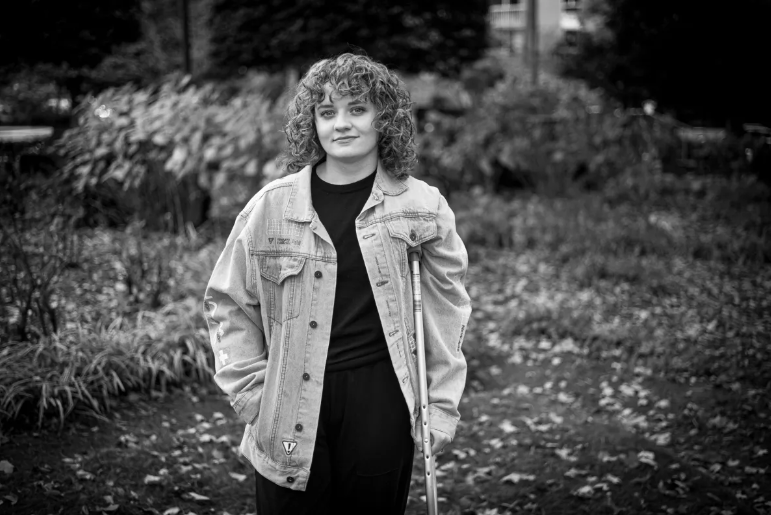Max Gorman of GRIDLOCK Dance Doesn’t Dream of Fair Pay, She’s Offering It
GRIDLOCK Dance founder Max Gorman; Credit: Darrow Montgomery
A dance student who wants to become a professional dancer can take one of two traditional paths. The first is auditioning to join a professional company as a trainee or apprentice. These programs act as a helpful bridge between student life and full-time work, but the pay is usually low. Before the Atlanta Ballet did away with its apprentice program in August 2022, their apprentices were paid less than $500 per week with no benefits. (The company now employs entry-level dancers who pass the main company audition as full company members who earn entry-level pay.) For many, these apprentice positions are only available to dancers who can rely on family support.
The other path is going to college, either an arts school or a university with a dance major. Between semesters, it’s ideal to participate in summer intensives to network and prepare for professional life—again, for little to no pay.
“That was not something I could afford to do,” says Max Gorman, who double-majored in dance and communications at Towson University. “I knew I needed a different way.”
Instead of getting in as an unpaid or underpaid dancer, Gorman leveraged her double major to get communications internships at places she wanted to dance. These positions included working for formerly local choreographer Christopher K. Morgan, at Dance Place in D.C., and at Jacob’s Pillow, the annual summer dance festival in Massachusetts. These gigs gave Gorman exposure and connections. “I got to see more dance than I’d ever seen in my life,” she says. But being there for communications, not dance, didn’t always feel ideal.
“I won’t say I didn’t sometimes feel a little sad seeing all the people … who were there for their contemporary intensive or their choreography intensives,” says Gorman.
After graduation in 2019, Gorman again had to get creative. Because she lives with chronic illnesses, health care was a top priority, and she wasn’t able to stay on her parents’ insurance. Of course, being a dancer means your livelihood is tied to your health and—like musicians, athletes, and construction workers—constant risk of injury that could prevent you from working.
“I needed to be able to make my own money and pay for myself to live,” Gorman explains. “I needed health insurance, and I needed good health insurance in order to be able to pay for my medications.”
Instead of going directly to dancing, Gorman took a full-time job with benefits in nonprofit communications. On the weekends and evenings, she performs with, choreographs for, and runs the contemporary dance company she founded in 2019, GRIDLOCK Dance. In a sense, Gorman is as much the double major as ever.
“The good thing is I really love [my full-time work], too,” says Gorman, though she admits that doing both makes for tricky branding. “How do I make a website about me when half my life is sort of advocacy, political communications? And the other part of me is making a contemporary dance about politics and media?”
These experiences—balancing a double major and, in a sense, a double career—has shaped how she runs GRIDLOCK, which has nine performers on its roster including herself. For example, they coordinate rehearsal times by sharing Google calendars, rather than assuming everyone has a day job and can dance at night, or vice versa.
When it comes to payment, Gorman only accepts opportunities that pay enough to provide fair compensation for both performances and rehearsals—not all jobs do—and is willing to adapt the company’s structure based on company members’ feedback. When GRIDLOCK first started, dancers received a set stipend, which is standard in D.C. for freelance artists. “But I realized through conversations with my dancers that sometimes there were certain dancers who were rehearsing a decent amount more than other people or were called for five more rehearsals or 10 more rehearsals,” says Gorman.
In response, the company moved to an hourly rate, so dancers who work more get paid more.
GRIDLOCK isn’t the only local organization thinking about how to provide equitable, well-paid dance work while challenging ingrained, inequitable practices. Dance Place gives local artists a discount off its $17 class rate. The nonprofit also runs a two-year Artist in Residence program that supports DMV-area creators whose work hasn’t received significant institutional support otherwise; the program provides rehearsal space, financial aid, professional connections, and performance opportunities.
Atlas Arts Lab runs a six-month development fellowship for several artists a year, providing rehearsal space and the chance to present an evening-length work. If this award sounds small, keep in mind that the Kennedy Center charges $1,320 to rent a 50-person studio daily from Monday to Thursday, and $1,760 for Fridays, Saturdays, and Sundays. Nonprofits receive about a $340 discount.
It’s not always financially easy for the organizations that fund dancers and dance companies, either. But Gorman believes there’s a way for both artists and organizations to better support each other—and many are.
For those who aren’t, Gorman invites people, “including myself, to think a little bit more deeply about the way they run things.”
This is part three of our Dancing in the Moonlight series that looks at how local dancers put together various part-time gigs and side hustles in order to support themselves.

